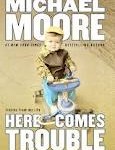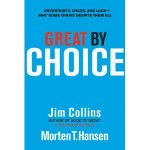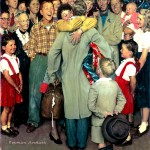Archive for the ‘Uncategorized’ Category
Education And Digital Natives
We Baby Boomers are “digital immigrants”. We’ve had to learn to adapt to computers, email, digital downloads, smartphones, texting, tablets, etc. The Millennials are “digital natives”. To them, the constant stream of rapidly changing media tools have always been a part of their lives. Here’s an interesting infographic about “digital natives” and learning courtesy of Elnora Lowe:

Via: Voxy Blog
Thanks to Fred Jacobs of Jacobs Media for bringing this info to our attention.
Here Comes Trouble

Let me begin by stating my belief that, whether you’re having a conversation, writing a book, posting a blog, sending a Facebook message, tweeting, doing a radio show, podcasting, or making a movie, it’s all about story-telling.
A recent article in Miller-McCune magazine reports that, based on scientific research, psychologist Jonathan Haidt has determined the beliefs you and I hold are really more the result of our genes and environment rather than immutable truths. Having established that ideology isn’t based in rationality, Haidt and his colleagues have come up with a framework of 5 moral foundations. They are care/harm, which makes us sensitive to signs of suffering and need; fairness/cheating, which alerts us to those who might take advantage of us; loyalty/betrayal, which binds us as team players; authority/subversion, which prompts us to respect rank and status; and sanctity/degradation, which inspires a sense of purity, both literally (physical cleanliness) and symbolically. The conviction that abortion, euthanasia, or gay marriage is immoral arises from the sanctity impulse.
Haidt says that American liberals respond most strongly to the care/harm and fairness/cheating impulses and tend to dismiss the others whereas conservatives (and the majority of people in the rest of the world) take all 5 moral foundations into account. Another way of interpreting this information might be that liberals tend to be more optimistic and see the glass half-full while conservatives tend to be more pessimistic and see it as half-empty.
There’s little doubt that Michael Moore is more influenced by the care/harm and fairness/cheating factors than by the others described. He waves his symbolic “freak flag” proudly and merely mentioning Michael Moore’s name provokes viscerally negative reactions from political conservatives and many independents, too. He’s viewed as a caricature of an old, unwashed, left-wing hippie troublemaker.
So it will be easy for those who disagree with Moore’s politics to reject this book as irrelevant. I think that would be a mistake.
I was surprised by the humanity that emanates from this collection of stories. I listened to the audiobook , which Moore narrates himself, and was struck several times by the thought that those who despise this man might gain some useful insights from hearing his stories about growing up in working class Flint, MI, his staunchly Republican mother, his encounters with Bobby Kennedy, Richard Nixon, Ronald Reagan, Harry Chapin, and John Lennon. And the life experiences which shaped Moore into the Quixotic documentary filmmaker that he is today.
You might laugh, you might cry, slam the book shut or shout at the dashboard, but you won’t be bored by the stories in HERE COMES TROUBLE.
How Ideals Power Growth & Profit
Jim Stengel is the former head of marketing for Proctor & Gamble. The ideas he expresses in this book are consistent to those being expressed by Daniel Pink in “A Whole New Mind” and Jim Collins in his latest book, “Great By Choice”.
Stengel preaches that it’s essential for business leaders to combine ideals and artistry, very right-brained functions, with rigorous left-brained analysis in order to create a brand leading product or service . He collaborated with WPP’s Millward Brown Optimor’s neuroscience unit to use MRI’s to measure how quickly people associate ideals with brands.
The Stengel 50 list was created from this research. These companies outperformed the S&P 500 by 400% over the first decade of this century. Most importantly, they discovered that associations with a brand’s perceived ideas have a strong relationship with consumer preference, consideration and choice.
According to Stengel, a Brand Ideal is the essence of the business which is embraced by everyone in the company , from the CEO to the receptionist, and is amplified by everything that the company does. In these cynical times, that’s a tough order. So, like Jim Collins’ concept of “the right person in the right seat on the bus”, Stengel has found that the leaders in his Stengel 50 companies devote a lot of time and attention to recruiting with the idea that one bad hire can be highly toxic.
Daniel Pink talks about the need to think “symphonically”. Apparently, Stengel agrees. He believes that CEO’s need to be “whole-brained” which , I believe, means that they need to take a holistic approach and to think in terms of decades rather than months, quarters, or years. He introduces the concept of the Brand Artist, someone who is accountable for the soul of the brand and its ideal. Stengel says that a company needs to measure its progress on the ideal not only with customers but with employees as well.
According to Stengel , a brand’s success relies on its ability to satisfy one of the following fundamental values: elicit joy, enable connection, inspire exploration, evoke pride, or positively impact society. Bottom-line: your brand has to walk the walk as well as talk the talk in a world that demands transparency and authenticity.
One company on the Stengel 50 list is Chipotle. I’ve never been to one of their restaurants and I thought of Chipotle as another Taco Bell-type franchise. Then, I saw their TV spot during the SuperBowl
and my attitude towards the Chipotle brand changed.
As usual, I “read” the audiobook version. At times, I found the writing to be a bit stilted. Nevertheless, I think you’ll find the stories about the various brands and the concepts in this book to be both useful and enlightening.
Great By Choice
The first time I learned about Jim Collins’ work was several years ago during my first job interview in a decade. I prepared for my interview by reviewing Harvey MacKay’s classic suggestions for responses to interview questions and doing my due diligence about the medical facility to which I was applying. However, when the interviewer’s first question was about how, in my position in the marketing/PR/communications department, I’d improve a patient’s experience, and then talked about getting the right people in the right seats on the bus, I knew that things had changed in the HR world.
“Great By Choice” is Jim Collins’ collaboration with his former student, Morten Hansen, to discover the facts and the myths about why certain organizations far exceed those of seemingly equal competitors. Collins and Hansen compare eight organizations: Southwest Airlines/ Pacific Southwest Airlines, Stryker/United States Surgical Corp., Progressive Insurance/Safeco Insurance, Intel/AMD, Microsoft/Apple, Amgen/Genetech, Biomet/Kirschner, and the 1911 Amundsen and Scott expeditions to reach the South Pole.
Collins and Hansen describe the high performers in their study cases as “10Xers” because these organizations didn’t just succeed but beat its industry index by at least 10 times. They identify three key characteristics of 10X leadership: fanatic discipline, empirical creativity, and productive paranoia. 10X leaders are passionately driven by a cause beyond themselves. As the authors note, all organizations experience both good and bad luck. It’s what one does with the luck they get which matters. They then offer their ideas about the characteristics which describe a “luck event”.
Collins and Hansen confront some entrenched myths to determine their validity. For instance, there’s the concept that a threat-filled world favors the speedy (“You’re either quick or dead”). Instead, the authors suggest that it’s better to figure out when it’s best to go fast and when it’s best to go slow. Also, there’s the firmly held belief that radical change on the outside requires radical internal changes. Collins & Hansen observe that just because an organization’s external environment is experiencing dramatic change it’s not necessarily a good idea for the organization to radically change itself.
“Great By Choice” presents some interesting concepts such as the “20 Mile March”, “Fire Bullets, Then Cannonballs”, “Return On Luck”, “Moore’s Law”, and SMaC. Collins’ and Hansen’s research presents useful answers to the question: Why do some companies thrive in uncertainty, even chaos, while other’s don’t?
No matter whether your endeavor is personal, public service-oriented, or in business, you’ll find the insights provided by this research to be helpful.
Michael Lewis’ Boomerang:Travels In The New Third World

Michael Lewis is his usual wry, witty, sardonic, self-deprecating, interesting and insightful self in this collection of articles which he wrote investigating what caused the financial problems in Europe and here in the U.S. He makes you laugh even though you know you should be crying.
The first character we meet is a Texas hedge fund manager who Lewis had edited out of his previous book, “The Big Short” because Lewis thought he was a whack job. Turns out, the guy was right and became very rich. He now collects guns, gold bars, lives in a fortress and is betting that Europe’s governments will fail. He’s hoping that his gun collection and fortress will protect his family and his gold bar collection when the world collapses into anarchy.
The first place we visit on Michael Lewis’ journey is Iceland where the hubris is astonishing. Essentially, a group of people who were adept at fishing decided that they could be good at banking. It was all guys. The women tried to warn them but the men wouldn’t listen. So the Icelanders bought into their own BS at highly inflated prices and then it all collapsed. Iceland’s population is small so the amount of money for which each citizen of Iceland is responsible is enormous
Next stop, Greece where the population feels entitled. Reading Lewis’ observations about the Greeks makes it apparent why they’re in their current economic situation. He recounts a story which I recall hearing about in the news. An angry mob firebombed a bank and several bank employees died as a result including a pregnant young woman. Rather than feeling compassion for the victims, the mob’s response was that it served them right for having the temerity to work rather than staying home and collecting from the government like any good citizen would do.
In Germany, Lewis learns that the citizens of Deutschland are quite scatological. The theory of why they’re this way is interesting. More importantly, we learn that although it’s very important to German society that everyone play by the rules, their bankers didn’t. In fact, though German bankers gave the outward impression that everything was on the up-and-up, they were enablers of those who were creating the financial crisis in Europe and here in America.
Which brings us back home. Lewis defends Meredith Whitney who garnered the ire of Wall Street when she decided to do some research about the financial health of America and discovered that the states were in pretty bad financial shape. The worst offender: California. Lewis introduces us to some inspiring community leaders who are working to cope with a situation created by citizens who demand public services but don’t want to pay for them. He also gets some surprisingly candid answers from former California governor, Arnold Schwarzenegger . The story about Arnold’s decision to run for governor is a classic.
One insight one comes away with after reading “Boomerang: Travels In The New Third World” is.. we’re screwed.
Reflections On 2011
Remember when you were a kid and it seemed to take forever for the holidays to arrive?
Now, every year seems to go by faster than the one before. Chalk it up to perception. When you’ve lived only 13 years, one year equals 1/13th of your life. When you’re thirty-five, a year equals 1/35th of your life. You get the picture.
I can’t say that the first year of the second decade of the 21st century has been my favorite year. But, as I reflect upon my personal experiences, I’m surprised at how many high points there are.
2011 marked a couple of significant anniversaries. My wife, Molly and I celebrated our 20th wedding anniversary in July. It amazes me that I’ve been married this long. In fact, it’s hard for me to think of myself now as not being married even though I maintained my bachelorhood longer than most.
This year also marked the Big 3-0 birthday of MTV: Music Television where I was privileged to be part of the channel’s original management team. It was fun to do some radio and print interviews about those early days at a channel which paved the way for television as we know it today. It was also nice to have my contribution acknowledged in the book, “I Want My MTV: The Uncensored Story of the Music Video Revolution” by Craig Marks and Rob Tannenbaum which was released in conjunction with the 30th anniversary.
Some other memories from 2011:
*My mother and younger brother spending the Christmas holidays with us in Saratoga.
*Our family vacation to Los Angeles and San Diego in March to visit with my wife’s cousin, John Woodcock and his wife, Susan. We were awakened at 8AM one morning at our beachfront hotel in San Diego by my daughter’s boyfriend in Saratoga who told us about the tsunami that hit Japan and was threatening America’s west coast. We’d gone to bed early and were oblivious to the situation. We certainly gained some perspective about what it’s like to live in Southern California.
*While in California, we were able to get some business done. Molly visited her client at TVG and met with the VP/Marketing at Santa Anita Raceway. I was able to meet with staff members at Loyola Marymount University’s student-run radio station, KXLU and to discuss media opportunities with former Albanian, Kevin Callahan while visiting him at KSON-FM, San Diego.
*Western Swing and Salsa dance lessons for Molly and me by our friend, David Levesque of Dancin’ Time. (She was good. Me, not so much.)
*Elton John with Leon Russell at Madison Square Garden in March. The tickets were a gift from my stepdaughter, Jessica.
*Being interviewed for Russian radio about American culture and media by my friend, journalist Vladimir Abarinov.
*Our youngest daughter, Sarah successfully transitioning from public high school to the private all-girl Emma Wilard School and embracing the experience of her senior year.
*The relief of learning that Sarah passed her driver’s test after being denied a passing score on her first 2 attempts.(I was dreading having to deal with an emotionally overwrought teenage girl who failed to pass on her 3rd try.)
*College campus visits with Sarah in July and October to New England, northern & western New York as well as the New York Finger Lakes region. I really enjoyed the conversations with my daughter and having the chance to watch her evolving maturity in handling the different situations we encountered during our trips.
It was good to make new friends during the past year and to reconnect with old friends and acquaintances such as: Joe Templin, Charles Warner, Scott Bingham, Dale Brooks, Michael Grace, Rosemary Young, Monica Mahaffey, Eric Strauss, Ray Patterson, Judi Clements, Bob Buchman, Jessie Scott, Mike Lembo, Batt Johnson, Pam Green, Rob Sisco, Hatem Dammak, Neerav Patel, Bill Polk, Susan Arbetter, Jay Werth, Bilel Besbes, Cindy Sivak, Rose Giangiobbe, Sierra Julie Sullivan, Dan & Jen Austin, Dick Heatherton, Joan Myers, Leslie Leventman, Tom Freston, George Gerrity, Holly Greene, Dale Willman, Ray Zoller, Joe Condon, Patrick Ryan, Michael Vallone, Joe Reilly, Dawn Dawson, David Levesque and Terry McNiff.
From a business standpoint, 2011 marked another year of evolution for Brindle Media with projects for Siena College and the New York Racing Association. My former boss at Albany Broadcasting, John Kelly asked me to work with Siena’s nationally-recognized radio station, WVCR-FM on focusing its programming product and strategizing for future development. During the summer, I once again worked with NYRA at world-renowned Saratoga Race Course to enhance the customer experience (CX) for and increase customer usage of the track’s computerized Self-Service Terminals (SSTs). In the Fall, I also created two targeted online newspapers using Paper.li, Buzz4Boomers designed for members of the Baby Boomer generation and 12866Buzz intended to provide news of neighborhood and social community interest for residents of Saratoga Springs. At this point, they’re both works in progress.
I tried to take advantage of as many learning opportunities as possible during the past year either by attending events such as Amy Mengel’s Social Media Breakfast Tech Valley, attending webinars, and reviewing audio or video interviews. Some webinars and interviews which I found enlightening this year included:
*Dan Zarella’s Hubspot webinars “Most Legendary Marketing Showdown”, “The Science of SEO”, “New Science of Social Media”, “The Science of Analytics”, “The Science of Timing” , and “The Science of Email Marketing”. www.Hubspot.com
*Reach Personal Branding’s Entrepreneurial Training Series www.ReachPersonalBranding.com
*Reach Personal Branding’s William Arruda’ss interviews with Tony Beshara, Gina Rudan, Seth Godin, Ken Blanchard, Stever Robbins, Bernadette Martin, Kevin Eikenberry, and Dr. Samantha Collins.
*Greig Well’s “Linkedin Insider Secrets” webinar.
*John Souza’s Social Media Magic University series about blogging, email marketing, PPC Marketing, Mobile Marketing, and SEO. www.SocialMediaMagicUniversity.com
*David Siteman Garland’s “Rise To The Top” interviews with Blogcast FM’s Srinivas Rao, Diamond Candles co-founder Justin Winter, social media legend Chris Brogan, author Steven Pressfield, and entrepreneur Lewis Howe. www.TheRiseToTheTop.com
*Daniel Pink’s “Office Hours” interviews with “Great By Choice” author Jim Collins and “The No A**-Hole Rule” author Bob Sutton. www.DanPink.com
*Edison Media’s Tom Webster’s presentation “Turning Social Media Monitoring Into Research”.
*Adam Metz’s webinar, “The Social Customer and The Art of War”. www.AdamMetz.com
*Mark Ramsey’s conversations with Ishita Gupta (from Seth Godin’s Domino Project), Livio Radio’s Jake Sigal, JINX’s Sean Gailey , Marketing Profs’ Ann Handley, Triton Media’s Jim Kerr, Pandora CEO Joe Kennedy, Guy Kawasaki, Seth Godin, Mandalay Entertainment Group chairman Peter Guber, Social Media Examiner’s Michael Stetzner, broadcast consultant & author Valerie Geller, KCRW-FM general
manager Jennifer Ferro, and advertising guru/author Jon Winsor. www.MarkRamseyMedia.com
I’m not a particularly fast reader so I rarely find time to read books. When I’m reading, it’s usually magazine articles or blogs. So, I’m a big fan of audiobooks. Some of my favorites this year were:
*David Brooks’ “The Social Animal”
*Tom Friedman’s “That Used To Be Us”
*Steven Levy’s “In The Plex”
*Tina Fey’s “Bossy Pants”
*David McCullough’s “The Greater Journey”
*Simon Winchester’s “Atlantic”
*Laura Hillenbrand’s “Unbroken”
*Sebastian Junger’s “War”
*Dick Cavett’s “Talk Show”
*Michael Lewis’ “Boomerang”
(I’ve just started listening to this book and I’m hooked).
You can read my reviews on my Linkedin account (www.Linkedin.com/in/REBuzzBrindle)
My favorite movies this year: “The King’s Speech” and “The Help”
In September, I drove downstate to NYC to see the play, “War Horse” at the Lincoln Center. I thought play itself was a bit trite but the design of the horse puppets and the puppetry itself were amazing. I’m debating whether or not to see the movie version.
My favorite TV shows remain CBS Sunday Morning, The Daily Show and The Colbert Report although my enjoyment of Colbert’s show is on the wane. It’s getting too predictable (like Rush Limbaugh’s talk show). This year, I’ve become a fan of NBC’s “Meet The Press”. With all due respect to the late Tim Russert , David Gregory has made the show much more interesting. “30 Rock” reruns have hooked me and I’m now looking forward to the show’s return in early January.” Saturday Night Live” is back on track. There’s a lot of talent in the current cast. I have to admit to enjoying the song & dance routines on “Glee” (talented cast, strong production). And PBS American Masters series ran a terrific documentary about Woody Allen this Fall. Watching “Midnight In Paris” is on my New Year’s Eve to-do list.
Best wishes for enlightenment, surprise, joy, good health, and prosperity in 2012.
Top TV Shows Of Conservatives & Liberals
The Experian Simmons annual survey of this year’s favorite TV shows ranked by political philosophy has been released. (Note that Independents and Libertarians aren’t listed.)
-
Conservatives’ Favs

1. Barrett-Jackson Auction
2. This Old House
3. The 700 Club
4. Swamp Loggers
5. Top Shot
6. The Bachelor
7. Castle
-
Liberals’ Favs

1. The Daily Show
2. Colbert Report
3. Masterpiece
4. 30 Rock
5. Parks and Recreation
6. The View
7. Glee
Your thoughts?







